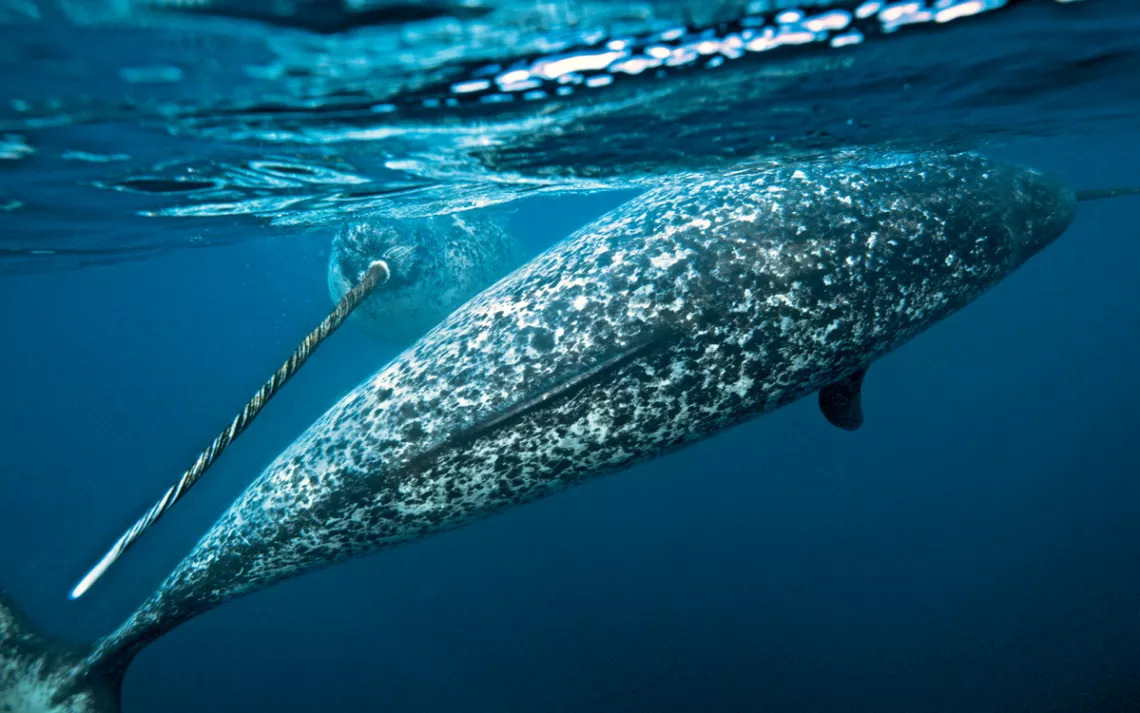Satellites Stalk Narwhals From Space, But They Still Keep Secrets
On being a mysterious being in a massive possible ocean

Photo by Paul Nicklen
Black unicorns are real. They are young narwhal whales diving in the deep channels and sounds of the Arctic Ocean. The flukes at the ends of their tails look like butterfly wings. The tusks coming out of their heads can be 10 feet long. Narwhals are so good at hiding in the ice at the top of the planet that for centuries they were a myth. For many years, European hunters hid the fact that narwhals existed so they could sell "unicorn horns" at a premium. Queen Elizabeth I once bought one for the price of a castle.
Right now, scientists are watching narwhal movement patterns from outer space. On a clear day, space-camera observers will notice how narwhals "seek areas of complex shoreline" to avoid orcas. We can watch 12,000 narwhals converge every summer in a place called Eclipse Sound. We can speculate about why narwhals on opposite sides of Greenland, separated for 100 centuries and genetically distinct from each other, appear to be changing their migration patterns in similar ways to adapt to melting ice.
Despite all the available technology, scientific understanding of narwhals seems clogged by human ideas of a gender binary and fantasies about the meaning of any long, pointy thing. A narwhal tusk is a tooth, the only tooth this particular whale has—unless it has two tusks, which some narwhals do. Field guides say that narwhals with tusks are usually male. But some female narwhals also have them.
A narwhal's tusk is a sensitive organ. It transmits pleasure. That means the narwhal play that scientists sometimes explain as male-dominance sword-fighting may be something else entirely. What would you rub against if you had 10 million nerve endings concentrated in one spiral?
Pleasure is a navigator. The narwhal's tusk senses changes in temperature, pressure, percussion. It accurately measures the levels of salt in the water. It reaches forward and translates all that information through a nerve that goes directly to the brain. Information transmitted by the tusk changes a narwhal's heart rate. The tusk gives the heart and mind details about the ocean of the narwhal's own existence.
Cheers to the narwhal for making it nearly impossible for humans to categorize it from a distance. Our clumsy fantasies say more about the lives of humans. We are the ones projecting wild assumptions from far away. We are the ones who grow up distrusting where our pleasure is leading us. We are the ones getting on each other's last nerve for no good reason.
Calling all unicorns. Will you join me? I'm betraying the image of who I am in some far-off person's fantasy. I'm trading it in for the message in my teeth, the map of my pleasure, the precise and changing temperature of this massive possible ocean.
This article appeared in the Summer 2022 quarterly edition with the headline "Black Unicorns Are Real."
Narwhals are classified as near threatened with extinction.
Like on a tree trunk, a new layer grows on a narwhal tusk each year.
Young narwhals are black. As they age, they become closer to the color of the ice in their habitat.
 The Magazine of The Sierra Club
The Magazine of The Sierra Club



